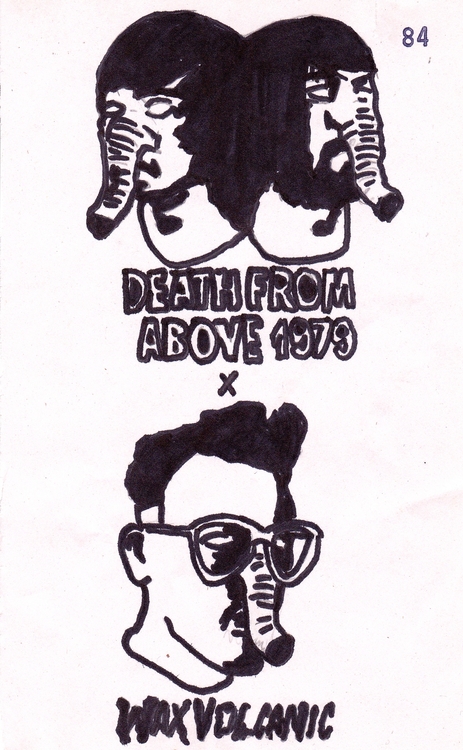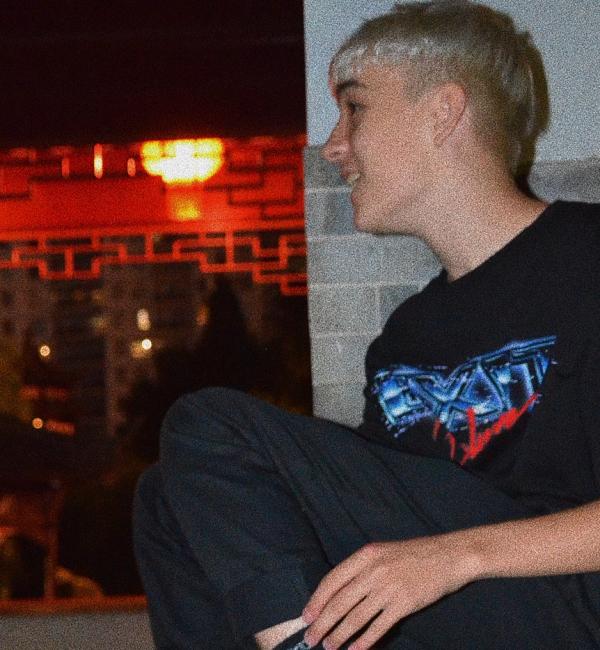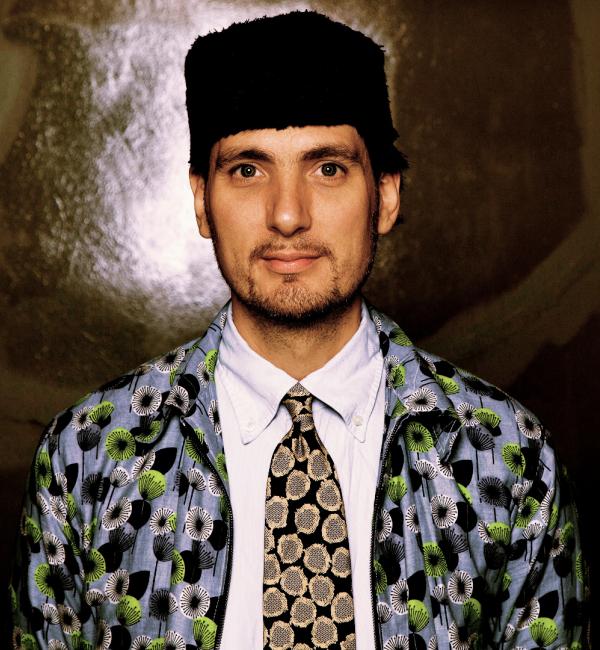
There’s the blonde policewoman hand-beating a rioter in the alley behind the Beauty Bar at SXSW. There’s the dune-like mass of bodies—overpacked and seemingly in stasis—at Coachella’s main stage. There’s the moment Sebastian Grainger and Jesse F Keeler apologised after not speaking for five years.
There’s no shortage of potent images from the disentombing of Death From Above 1979. But if a single central image had to be chosen, one that most comprehensively frames the resurrection of the band, it would have to be from the secret show they played in Toronto earlier this month. It was, similar to the unruly shows of the band’s provenance, in a parking lot. Except this time, the parking lot belonged to the Edward Day Gallery—located next to the Museum of Canadian Contemporary Art— and had been hired for the show.
Jesse F Keeler is the first to admit that things have changed since the band’s explosive self-exhuming in 2011.
“Now we walk in the room with hundreds of thousands of kids behind us” Keeler says of DFA 1979’s more recent summits with industry. “Compare now to back in the day and it’s a whole new experience, it’s wonderful. I still don’t shower before those meetings though. On principal.” As he recounts stories of being applauded in boardrooms (true stories I’m assured) Keeler seems ignited with the kind of faith generated by unstoppable force—the force of the deathless. And it’s faith well founded. There’s a palpable excitement and disbelief surrounding DFA 1979’s return, an excitement that extends beyond the immediate ambit of DFA fans and deep into the furthest corners of the music industry. Amid the scrutiny and anticipation of their reformation, one question that hangs dense and steam-like over the reforged duo since Coachella 2011, which is: are they the true architects of their own resurrection or willingly caught up in the acute excitement of external parties?
“Well I know it’s not the second thing for me…” Keeler yawns. “I really take a lot of enjoyment in disappointing people and being the guy at the party that makes the party end. I don’t know. I just see an excited crowd and I just wanna go out there and really hammer the shit out of them and still see if they like it when it’s over…”
And DFA 1979 still seem to enjoy hammering the shit out of people. The Physical World has the same convulsive snarl and thunderous swagger that 2006’s You’re a Woman I’m a Machine was so famous for. There’s something almost compulsively kinetic about the album. From the opening shrieks of ‘Cheap Talk’ to the haunted strains of ‘The Physical World’, the album only draws breath during the smog-cloaked fabulism of ‘White is Red’.
“The challenge is trying to capture the band on the recording like how it feels for us to play” Keeler winces. “I don’t know if that’s ever really possible but I think we got closer this time…”
But despite feeling closer to invoking their live sound on record, DFA 1979 made almost no radical changes to their approach. In much the same way as he did over a decade ago, Keeler wrote around 6 songs on bass and sketched out some drum ideas before sending them to Sebastian Grainger, who laid his own ideas on the demos. By the time they finally convened in the studio, Keeler and Grainger made sure they had nudged the bulk of their songs to near-completion. Neither member of DFA 1979, according to Keeler, likes to be in the studio without a plan.
“It’s one thing to be under pressure” Keeler reasons “but this is going to outlive me [so] its gotta be right. I’m gonna put my name on it…and answer questions about it when people call me from Australia so I gotta make sure that I like it.”
The only notable change to the process on The Physical World, was the incorporation of an external producer—in this case Dave Sardy, whose production credits list Oasis alongside Jay-Z, Johnny Cash and Marilyn Manson, among a profusion of other household names. By the time Keeler and Grainger had met Sardy, most of the album was completed, so he was used a pair of extra ears, to correct any structural glitches that had been cloaked by over-familiarity and left unchecked.
“So we sort of met up and played him everything and as we’d go through songs he’d ask questions like: ‘what’s that part? Is that the chorus? It’s not? Why isn’t that part the chorus? It’s the best part’ So we were like ‘okay, maybe yeah’…”
Whatever roles were occupied and differences carefully rebalanced, they undisputedly captured their old sound. And after a few listens, songs like ‘Crystal Ball’ and ‘Right On Frankstein’ become impossible to deny.
“If you imagine that the world of DFA is a circle” explains Keeler, “then what we wanted to do is kick that circle out and make it bigger but in every direction. Keep it a circle but push it out in every way… a little faster, a little heavier, a little more musical, a little poppier, a little softer.” Which is precisely what The Physical World sounds like. It’s not a distillation of the band’s core essence, but nor is it a wild departure. It’s simply a nudge outwards. But this raises irresistibly (despairingly) the question of growth. How might they have matured if they could have done it together rather than separately? There’s still the nagging sense that we could just be listening to a retreat to their old sound. Who knows, if they had remained and grown together, what they would sound like today? It’s a ludicrous line of logic, an irresistible one nonetheless.
Let’s return once more to our central image—the carefully organised parking lot show outside the Canadian Museum of Modern Art. This image is far more than just an expression of how DFA 1979 have been concretely empowered by their absence. More compelling is its crystalline illustration of how the band is now perceived—less as a rock band and more as an apparition or monument of disbelief. And DFA 1979 know it. It’s what drove the ferocity of the small riot at SXSW and what is drawing fans moth-like to their shows in waves of awe.
“The thing that me and Sebastian have spoken about a lot when we see people getting excited is: ‘do they know? Do they know what they’re excited about? I mean it’s been so long. They’re excited by an idea but they’re not actually excited about us because they couldn’t be, it’s anticipation built on something else…” But this, of course, makes it hard for the band. If people become absorbed by the mythology of DFA 1979, then they become instantly impossible to please. They must sound as unremittingly wild and new as they did upon first listen, simultaneously recapturing the youth and embracing the matured tastes of their fans. Which is basically impossible. Especially for two guys who just want to be in a rock band, which is “all [they] think of [them]selves as” implores Keeler.
But in the end, there really is no pleasing everybody, and DFA 1979 have made a fairly easy peace with it all. Keeler, through his DJing with MSRKRFT saw, in the merciless pace of the dance music world, how audiences change.
“People are always in a state of change, there’s no constant…I fully expect that there are fans that were around in the past who won’t like what we’re doing now, and there will be new fans that will only know this stuff now and look into the other records later on. That’s okay. Noone needs to pledge alligiance.”
I happen to think DFA 1979 have made a pretty great album this year. And despite the hype, the history, the myth or the venue, it’s still no more than it claims to be—the consummate execution of a strikingly simple idea.
“Once you’re up there, there’s the gear that I know and the guy that I’m in the band with…it’s cool that there’s people out there that seem to be enjoying it. But in the end,” Keeler says, “every stage ends up being the same.”
FOR COOL ACCIDENTS
Death From Above 1979’s loooooong overdue second record The Physical World is available now where all good music is sold | streamed






